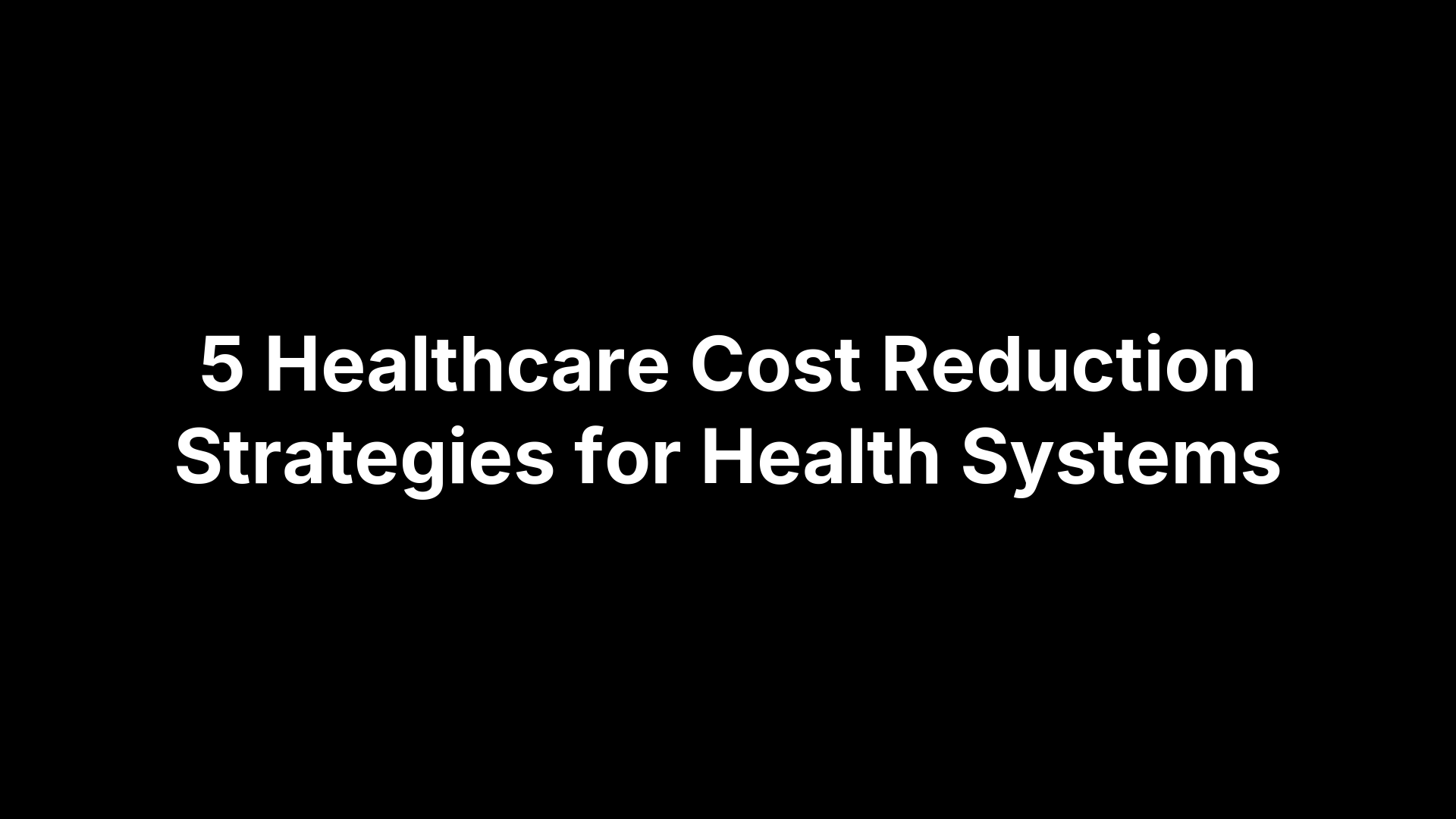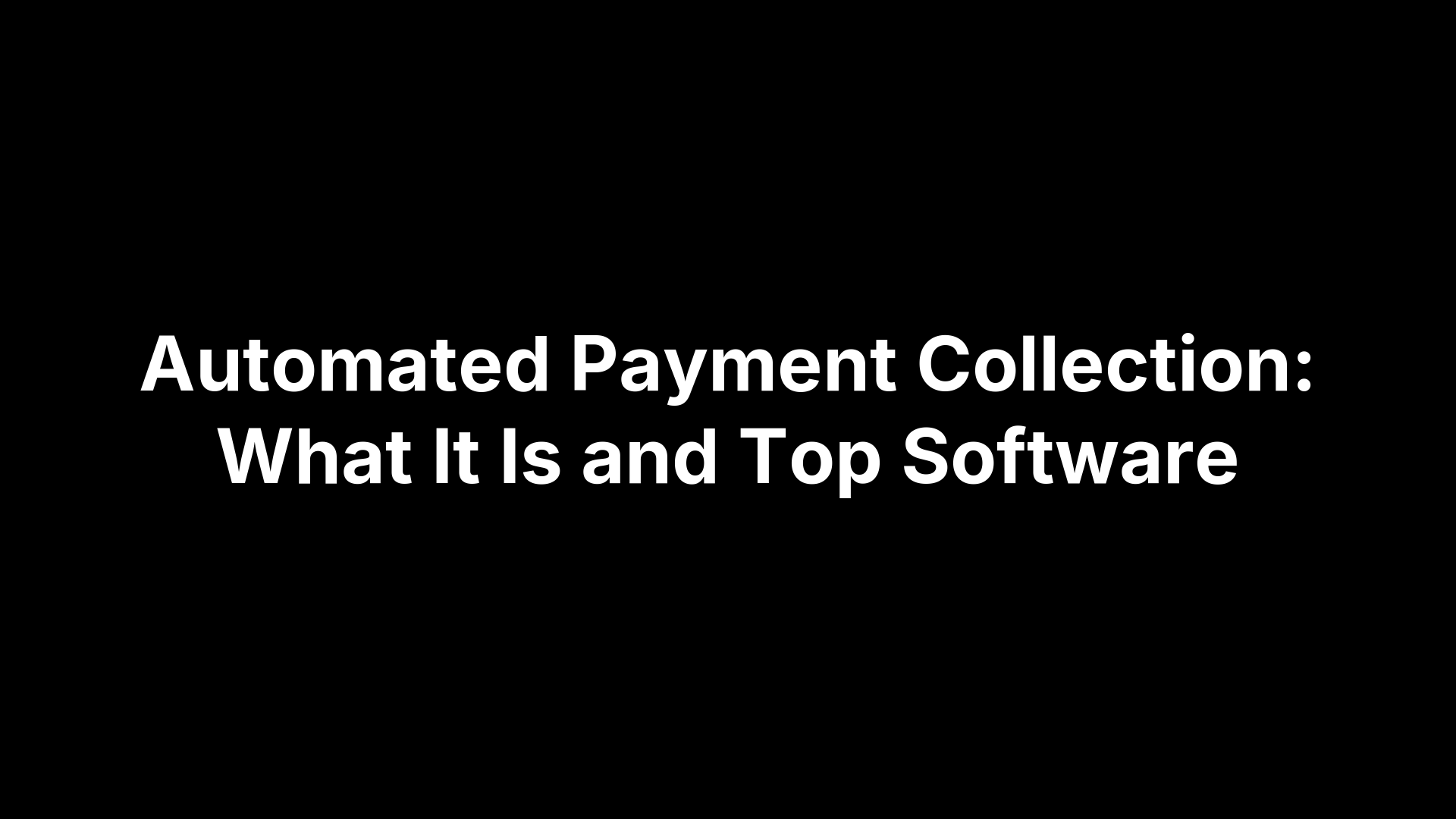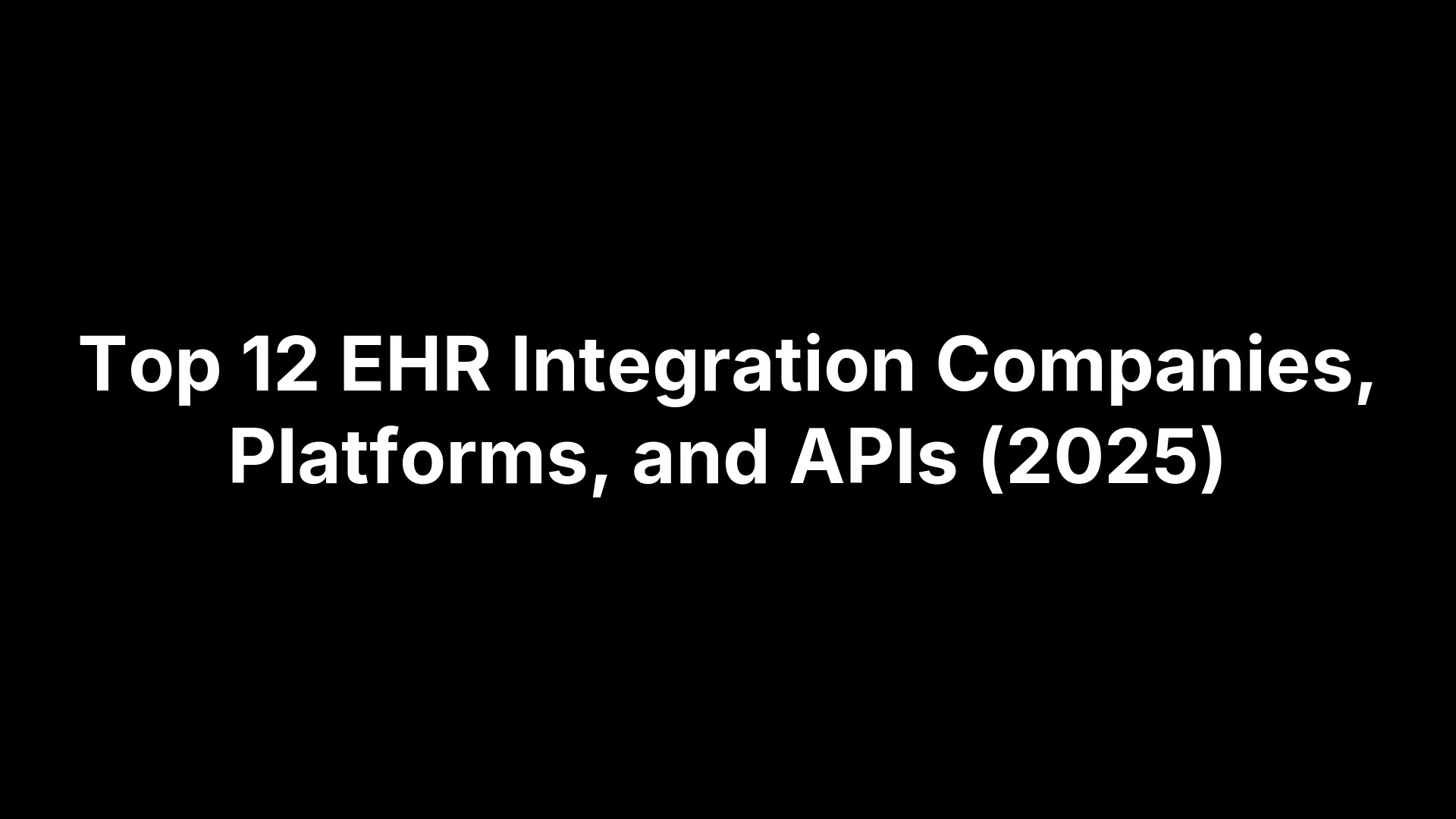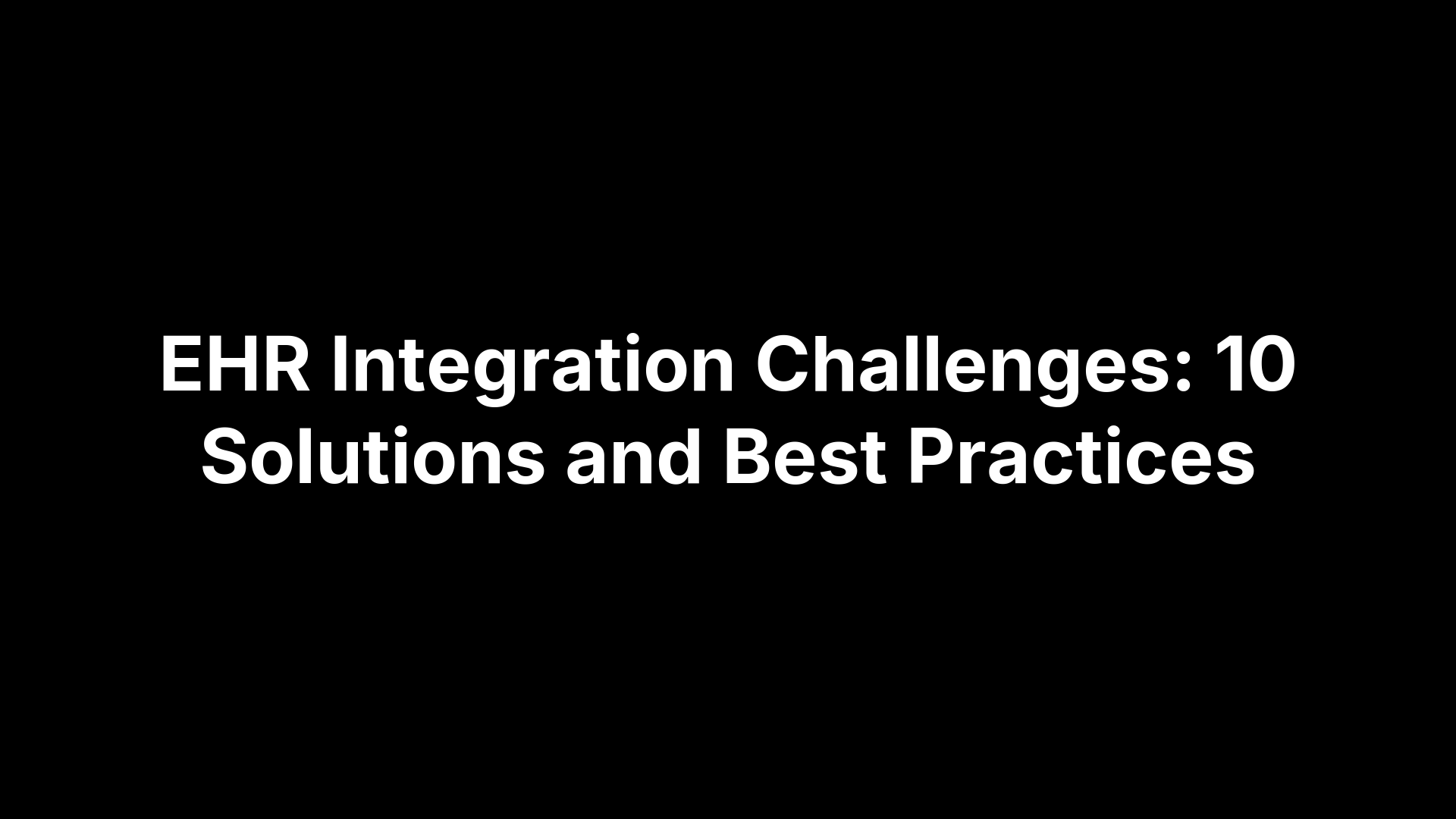The Complete Guide to Automating Healthcare Processes

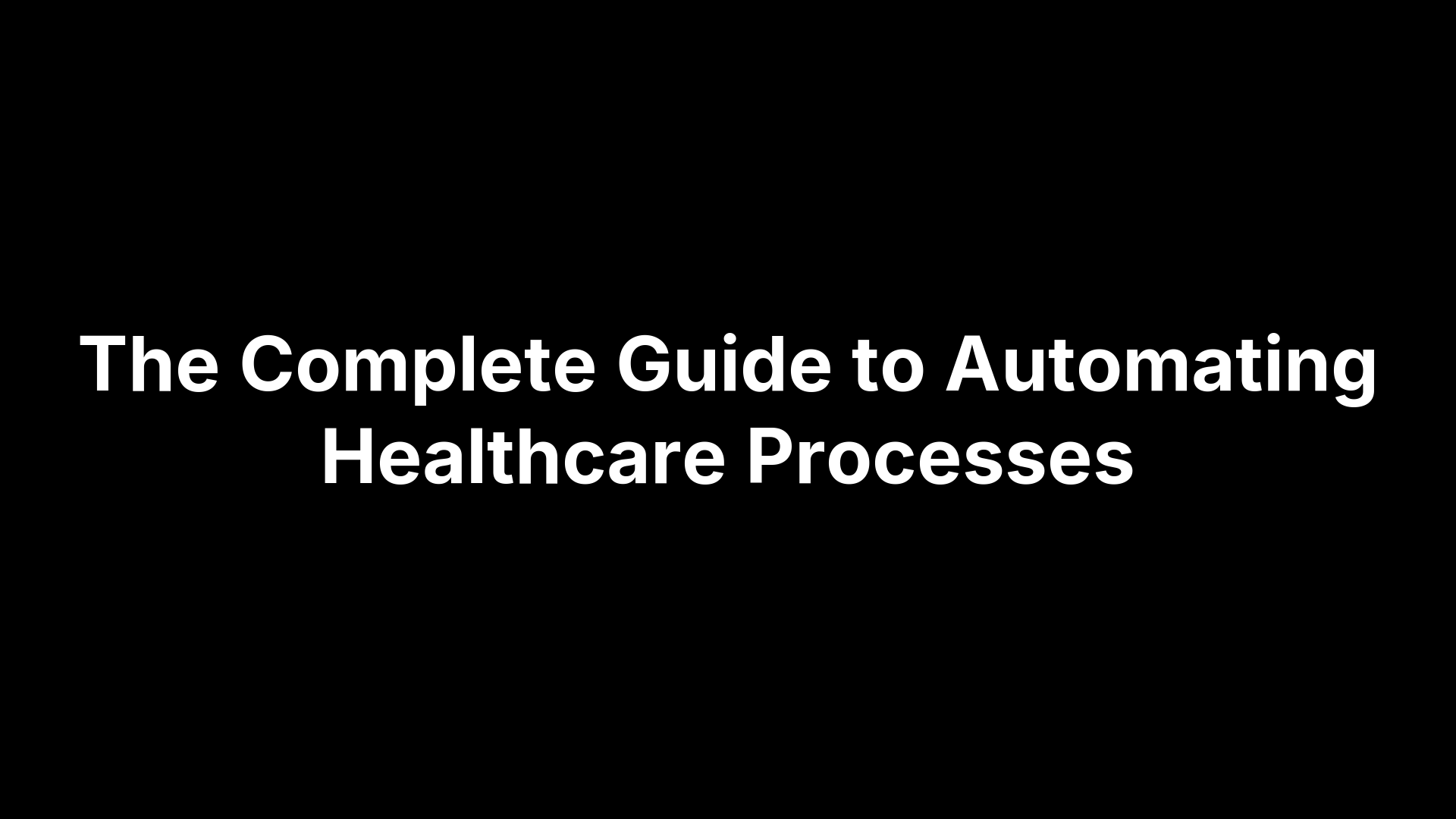
The Complete Guide to Automating Healthcare Processes
Automating healthcare processes means using software, AI, and connected systems to take over repeatable, rules-based work across clinical and administrative workflows. Think of it as building reliable “assistants” that schedule appointments, capture intake data, route orders, verify eligibility, submit and reconcile claims, coordinate transport and home services, track DME deliveries, and surface the right information to the right person at the right time. Done well, automation shortens cycle times, reduces errors and phone tag, improves handoffs between teams and vendors, and frees clinicians and staff to focus on higher‑value work and patient care.
This guide shows you exactly how to get there. You’ll see where automation fits across the patient journey and back office, the first use cases that return measurable value, and the technologies behind modern automation. We’ll cover integration with EHR, CAD, and billing systems; data quality and standardization; governance, privacy, and compliance; and how to build a business case with KPIs that matter. You’ll get an implementation roadmap, change‑management tips for human‑in‑the‑loop design, risk mitigations, a vendor checklist, and a glossary—so you can move from scattered pilots to scalable, safe, and ROI‑positive automation. Let’s start with why it matters now.
Why automating healthcare processes matters now
Healthcare can’t afford manual, phone‑driven workflows anymore. Administrative costs consume roughly 40% of hospital expenses, and workers spend up to 30% of their day on non‑care tasks. At the same time, the healthcare automation market is accelerating—from about $38B in 2024 toward ~$63B by 2030—because organizations see measurable wins: fewer errors, faster throughput, and happier staff and patients. Advances in AI and analytics now make it practical to automate everything from intake and eligibility to claims integrity, remote monitoring alerts, and security threat detection, turning fragmented workflows into predictable, auditable processes.
The payoff shows up quickly in both revenue and care quality. Deloitte estimates billing automation can free nearly half of a revenue cycle professional’s time, while AI‑assisted decision support and documentation reduce clinical burden and speed up care. Practically, automating healthcare processes helps leaders:
- Recover capacity: Reallocate hours from data entry and phone tag to patient care.
- Cut leakage and denials: Standardize coding, prior auth, and clean claims.
- Improve safety and compliance: Enforce access controls and generate audit‑ready trails by default.
The automation map across the patient journey and operations
Automating healthcare processes works best as an end‑to‑end system, not point fixes. Map the patient journey alongside operational layers to find handoffs, duplicate work, and lag times you can eliminate. Below is a practical view of where automation slots in, from first referral to ongoing care and the back office that supports it.
- Referral & orders: eReferrals, eligibility checks, prior authorization, benefit verification, and service routing.
- Pre‑visit: Digital intake, document capture/extraction, insurance verification, scheduling, and automated reminders.
- Arrival & in‑facility: Self check‑in, ID/coverage re‑verify, real‑time care team messaging, and ambient documentation.
- Diagnostics & treatment: Order sets, image/lab triage, decision‑support prompts, and results routing to the EHR.
- Discharge & transitions: Auto‑generated summaries, e‑prescribe, follow‑ups, transport coordination, and home health/DME orders.
- At home: Remote monitoring alerts, medication adherence nudges, surveys/PROs, and telehealth triggers when thresholds trip.
- Patient logistics: Dispatching and ETA tracking for NEMT/EMS, home care visits, DME and prescription delivery.
- Revenue cycle: Charge capture, coding assistance, claim edits, submissions, denial worklists, and payment plans.
- Operations & compliance: Vendor onboarding/credentialing, policy enforcement, audit trails, and cybersecurity threat monitoring.
- Analytics & planning: Throughput dashboards, capacity and staffing models, cost‑to‑serve, and contract performance.
Next, prioritize the use cases that return fast, measurable value.
High-value use cases to automate first
The quickest wins come from high‑volume, rules‑based steps that fuel phone tag, rework, denials, or delays. When automating healthcare processes, prioritize work with clear owners, clean inputs, and 1–2 system integrations, where impact is measurable in no‑shows, handoff time, days in AR, or hours returned to staff. Start here to build momentum and fund the next wave.
- Digital intake and document capture: Extract IDs, consents, and histories with OCR/NLP and map into the EHR to cut errors and manual typing.
- Smart scheduling and reminders: Offer self‑scheduling with SMS/email nudges; integrate with EHR to reduce inbound calls and no‑shows.
- Eligibility, prior auth, and financial clearance: Automate checks and routing up front to prevent downstream denials and patient friction.
- Claims edits and denial workflows: Standardize coding, scrub claims, route denials; billing automation can free nearly half of a revenue cycle professional’s time.
- Patient transport and DME dispatching: Auto‑dispatch, rate lookup, ETA tracking, secure messaging, and PCS e‑signatures; organizations report up to a 90% cut in scheduling time and substantial cost savings.
- Discharge orchestration: Auto‑generate packets, e‑prescribe, schedule follow‑ups, and coordinate home health/DME orders to speed safe transitions.
- Remote monitoring alert triage: Filter normal streams and escalate only exceptions; trigger telehealth or outreach based on thresholds.
- Vendor onboarding and credentialing: Automate collection of licenses, policies, and access rights to enforce compliance and create audit‑ready trails.
Administrative and revenue cycle automations that pay off
If you need quick, defensible ROI, start with the administrative and revenue cycle. Administrative costs can reach 40% of hospital expense, and Deloitte estimates billing automation alone can free nearly half of a revenue cycle professional’s time. Automating healthcare processes here standardizes front‑, mid‑, and back‑end tasks so fewer claims bounce, cash arrives faster, and staff escape manual rework.
- Eligibility, benefits, and prior auth: Auto‑verify coverage and route preauthorizations using decision trees to prevent downstream denials and delays.
- Charge capture and coding assistance: Extract data from documentation, apply coding rules, and scrub claims before they leave the door.
- Claims submission and status: Auto‑submit, monitor payer responses, and trigger exception queues only when human review is needed.
- Denials and appeals workflows: Triage by reason code, auto‑generate appeal packets for fixable errors, and close the loop on root causes.
- Payment posting and reconciliation: Auto‑post remits, match to encounters, and flag under/over‑payments for integrity review and collections.
- Patient financial communications: Send digital statements, estimates, and payment plans with SMS/email nudges to accelerate self‑pay.
- Compliance and audit trails: Enforce access rights and produce audit‑ready logs by default.
- Service‑linked invoicing: Tie transport, home care, and DME completion events to automated invoicing with ACH/credit card options to shorten AR.
Use real‑time dashboards to track clean claim rates, denial volume, aging, and staff time returned—then reinvest those gains into clinical and care‑coordination automations next.
Clinical and care coordination automations that elevate care
When automating healthcare processes on the clinical side, the mission is simple: remove documentation drag, keep teams in sync, and surface the right signal at the right moment. Automation augments clinicians—not replaces them—by handling repeatable steps and routing information so decisions are faster, safer, and more consistent across settings. The result is more time with patients, fewer missed handoffs, and measurable gains in quality and throughput.
- Ambient documentation and NLP summaries: Draft visit notes and summaries from structured/unstructured inputs so clinicians spend less time typing and more time listening.
- Diagnostic support and results triage: Analyze images and large data sets to flag abnormalities, prioritize worklists, and present evidence-based prompts for next-best actions.
- Care transitions and discharge packs: Auto‑generate discharge instructions, e‑prescriptions, referrals, and follow‑ups to reduce readmissions and speed safe handoffs.
- Remote patient monitoring alerts: Continuously ingest wearable/device data, suppress normal readings, and escalate only when intervention thresholds are crossed.
- Medication management and adherence: Support automated dispensing in‑house and send refill/adherence nudges post‑discharge to improve outcomes.
- Order routing and coordination: Standardize order sets, route tasks to the right role, and confirm completion with secure, auditable messaging.
- Patient‑reported outcomes and surveys: Automate outreach to capture symptoms and satisfaction, closing loops when responses indicate risk.
Next, extend the same orchestration to patient logistics for transport, home care, and DME.
Patient logistics automation for transport, home care, and DME
Discharges stall when a ride isn’t lined up, home health isn’t confirmed, or DME never makes it to the doorstep. Automating healthcare processes across patient logistics orchestrates these moving parts—transport, home care, and equipment—without phone tag or blind spots. Health systems using unified logistics see dramatic gains, including up to a 90% cut in scheduling time and six‑figure annual savings from fewer avoidable bed days and rework, while patients experience smoother, safer transitions.
- Unified e‑orders: Trigger transport, home health, and DME from one order with service type, acuity, equipment, and payer rules—no rekeying from the EHR or care‑management systems.
- Auto‑triage and dispatch: Match requests to the best vendor by capability, SLA, proximity, and rate; AI agents schedule, negotiate, and update in real time, integrating with CAD as needed.
- Eligibility, auth, and PCS e‑signatures: Capture medical necessity, verify benefits, and collect signatures digitally to prevent downstream denials.
- Live ETAs and secure messaging: GPS/ETA tracking with two‑way, auditable messaging keeps units, patients, and families aligned.
- DME and home‑care orchestration: Check stock, schedule delivery/visit windows, and capture proof‑of‑delivery/setup and education.
- Vendor network and compliance: Onboard, credential, enforce policies, and score vendors with incident logs and performance dashboards.
- Exception handling: Auto‑escalate delays, no‑shows, and cancels; rebook with alternates and document the trail.
- Billing and payment: Apply rate cards, invoice on completion, accept ACH/card, and reconcile to encounters automatically.
- Actionable insights: Track on‑time %, sit‑to‑discharge, avoidable days, cost‑per‑trip/visit, and denial reduction to tune operations.
The result: faster, safer discharges, predictable home starts, and fewer surprises. Next, reinforce the journey with communication and engagement automations that keep patients on track between visits.
Communication and patient engagement automations that stick
Patient engagement that sticks is less about blasting generic messages and more about timing and context. When you embed outreach triggers into operational systems—scheduling, discharge, transport, and remote monitoring—messages arrive when they matter, over the channel patients prefer. Automating healthcare processes here reduces no‑shows, boosts adherence, and keeps care moving at home and in clinic.
- Smart appointment lifecycle: Confirmations, prep instructions, and SMS/email reminders with easy reschedule and portal pre‑visit forms.
- Two‑way secure messaging: Route questions to the right role, capture threads to the record, and cut phone tag.
- RPM‑triggered outreach: Suppress normal streams; escalate exceptions with a telehealth link or nurse callback.
- Medication and refill nudges: Refill prompts, delivery status updates, and adherence check‑ins tied to the care plan.
- Discharge follow‑ups: Day‑2 symptom check, transport for follow‑up, and home‑care/DME confirmation with proof‑of‑delivery.
- Automated surveys and PROs: Send HCAHPS and post‑visit surveys; auto‑open tasks when scores signal risk.
- Clear financial communications: Digital estimates, statements, payment plans, and reminders that shorten time to pay.
- Preferences, consent, and language: Honor opt‑ins, channel/language choices, and maintain audit‑ready logs for HIPAA.
Done this way, outreach augments the in‑person experience, closes care gaps between visits, and builds trusted, repeatable touchpoints without adding staff burden.
The tech stack behind modern healthcare automation
Automating healthcare processes works when your stack is modular, secure, and built for interoperability. Think cloud‑first workflow engines that orchestrate rules and AI, anchored by systems of record (EHR/EMR, CAD, billing). Event‑driven integrations move data in near real time; RPA fills gaps for legacy apps. NLP handles document intake, while analytics surface exceptions. Every action is auditable, PHI is encrypted, and access is least‑privilege by default—so automation scales without compromising compliance or clinical safety.
- Systems of record: EHR/EMR, EMS CAD, RCM/billing, directory/credentialing as authoritative sources.
- Integration and eventing: FHIR/HL7/X12, REST APIs, SFTP, and message brokers for real‑time triggers.
- Automation and orchestration: No‑code workflows, rules engines, task queues, timers, and human‑in‑the‑loop steps.
- AI/ML and NLP: Document extraction, classification, summaries, predictive models, and decision support.
- IoMT and RPM ingestion: Secure device feeds, normalization, thresholding, and alert routing to care teams.
- Security, compliance, observability: SSO, RBAC/ABAC, encryption, secrets, audit logs, threat monitoring, tracing.
- Data and analytics: Operational store plus warehouse/lake, MDM/terminology services, dashboards, and KPIs.
Integration and interoperability essentials with EHR, CAD, and billing
Automation breaks when data can’t move. To truly succeed at automating healthcare processes, connect your EHR, EMS CAD, and billing stack with standards‑first, event‑driven integrations so orders, eligibility, dispatch status, and financials flow without rekeying. The goal: create reliable triggers (order placed, unit en route, service completed, remit posted) that orchestrate downstream work automatically, with humans stepping in only for exceptions.
- Standards first: Use FHIR/HL7 for clinical data, X12 for eligibility, claims, and remits; prefer REST APIs and webhooks for near real‑time, with SFTP/batch as a fallback.
- Event‑driven orchestration: Publish admission, order, dispatch, completion, and payment events through a message broker so workflows react in seconds, not days.
- Identity and matching: Maintain a master view of patient, member, provider, and vendor identities; prevent duplicates and keep source‑of‑truth rules clear.
- Field mapping and contracts: Normalize codes and units, define versioned integration contracts, and validate payloads to avoid brittle point‑to‑point fixes.
- Security by design: Enforce SSO and least‑privilege access, encrypt data in transit/at rest, and capture audit logs for every read/write.
- CAD specifics: Sync two‑way status, capabilities, and ETAs; map service requests to the right unit and reflect real‑time updates back to care teams and patients.
- Billing specifics: Automate eligibility and preauth checks up front; push clean charges, receive payer responses, and drive worklists from claim status and remits.
- Observability: Monitor interfaces with dashboards and alerts; surface failed messages and auto‑retry while routing true exceptions to humans.
Nail these essentials and your integrations become the backbone that keeps clinical, logistics, and revenue workflows in lockstep—without phone tag or swivel‑chair work.
Data quality and process standardization as automation prerequisites
Automation multiplies the quality of whatever you feed it. If inputs are incomplete, duplicated, or inconsistently coded, you’ll automate errors, denials, and rework at scale. Before automating healthcare processes, normalize unstructured documents with OCR/NLP, standardize fields and codes across sources, and define a single source of truth. Establish clear, step‑by‑step workflows so software knows when to act and when to escalate. SERP sources highlight that normalized data boosts accuracy, while governance over data quality and interoperability prevents missed triggers and false positives. Ground everything in standards (FHIR/HL7 for clinical, X12 for eligibility/claims) and enforce validation at the edge, not after the fact.
- Canonical data model: Define required fields, formats, and code sets across systems.
- Master data & matching: Create golden records with merge rules for patients, providers, vendors.
- Edge validation: Enforce field checks, picklists, and benefit/eligibility rules at capture.
- Document normalization: Use OCR/NLP to extract, classify, and map to the model.
- Process playbooks: Versioned swimlanes, SLAs, exception paths, and human approval points.
- Data quality KPIs: Track completeness, timeliness, duplicates, error/denial rates; monitor and tune.
Governance, privacy, and compliance from day one
Automation won’t lower your risk unless governance is built in. From the first pilot, design automating healthcare processes with privacy‑by‑design, least‑privilege access, and auditable workflows. SERP sources stress that automated systems can enforce compliance (role‑based access) and continuously monitor for security threats—so use those strengths. Pair them with human oversight for clinical decisions and transparent AI practices to prevent bias. Make vendor compliance first‑class: credentialing, policy enforcement, and clear data‑processing terms keep PHI protected across your ecosystem.
- Regulatory baseline: Map data flows to HIPAA and applicable state rules; apply “minimum necessary,” and execute BAAs with processors.
- Access control by default: Enforce SSO, MFA, RBAC/ABAC, and time‑boxed access; log all “break‑glass” events.
- Encrypt and audit everything: Encrypt in transit/at rest; maintain immutable audit logs, retention policies, and exportable evidence.
- Automated compliance monitoring: Baseline configs, scan for drift, and use threat detection to separate true risks from false positives—and auto‑mitigate where approved.
- Vendor governance: Automate onboarding, credential checks, policy attestation, and ongoing performance/compliance scoring.
- AI model oversight: Document training data limits and known biases; keep humans in the loop for high‑impact decisions and record provenance.
- Consentful communications: Capture consent/preferences, restrict PHI in outreach, and honor language/channel choices with audit‑ready trails.
Building your business case and KPIs to track
Executives fund what they can measure. Anchor your case for automating healthcare processes in baselines, hard-dollar savings, and time-to-value, then use operational and clinical KPIs to prove lift and reinvest. Tie benefits to known pressure points: administrative costs near 40% of hospital expense, and billing automation that can free nearly half of a revenue cycle professional’s time. Build a 12–18 month model with staged releases and clear ownership.
-
Financial outcomes: Clean-claim rate, first-pass yield, denial rate/recouped $, days in AR, cost-to-collect, avoidable bed days, cost per trip/visit, payer mix impact.
-
Operational efficiency: Staff hours returned, cycle time by workflow (intake→claim, order→dispatch→completion), on-time %, sit-to-discharge, no-show rate.
-
Care quality & access: Readmissions (7/30-day where applicable), time to follow-up, RPM exception-to-contact time, medication adherence touchpoints completed.
-
Patient experience: Response-time SLAs, survey completion rate, HCAHPS/top-box movement, complaint-to-resolution time.
-
Compliance & security: PHI access exceptions, audit findings resolved, vendor credential currency, policy attestations on time.
-
Attribution tactics: Use pre/post baselines, control cohorts, and exception queues to isolate impact.
-
ROI shorthand:
ROI = (Annual benefits – Annual costs) / Annual costs -
Stage gates: Release → measure → tune → expand; publish dashboards and reinvest verified savings into the next wave (e.g., from RCM into logistics and care coordination).
A practical roadmap to implement and scale automation
You don’t need a big‑bang overhaul to see results. The most reliable path is staged: prove value on high‑volume, rules‑based work, then expand to adjacent processes while hardening data, security, and governance. The outcome is compounding ROI—fewer denials, faster discharges, and hours returned to staff—without disrupting clinical care or compliance.
- Stand up governance: Form a cross‑functional committee (clinical, ops, IT, compliance, finance) to set scope, risk controls, and vendor criteria.
- Audit workflows and baselines: Time-motion studies and defect logs reveal candidates; capture pre‑pilot KPIs to prove lift.
- Prioritize 1–2 pilots: Pick high‑volume, low‑variance steps (e.g., intake, eligibility/prior auth, claims edits, dispatching) with clear owners.
- Prep data and integrations: Define required fields and codes, validate at capture, and connect via FHIR/HL7/X12 APIs; execute BAAs and least‑privilege access.
- Design with guardrails: Map SLAs, exception paths, and human‑in‑the‑loop approvals; enable audit trails by default.
- Build, test, and harden: Use no‑code workflows plus RPA only where APIs don’t exist; test with de‑identified data before go‑live.
- Pilot, measure, expand: Compare pre/post metrics and control cohorts; templatize what works, then scale to adjacent processes (e.g., discharge → home care/DME → billing).
Rinse and repeat: monitor dashboards, tune rules and models, retire manual steps, and reinvest verified savings into the next wave.
Change management and human-in-the-loop design
Technology doesn’t change care—people do. The fastest way to sink automating healthcare processes is to roll out “black box” bots without context or control. Set the expectation that automation augments roles, not replaces them, and that clinicians, dispatchers, and revenue teams remain the deciders for high‑impact steps. SERP sources emphasize workforce adaptation, human oversight, and bias awareness—so design processes where humans supervise, approve, and can easily override when stakes are clinical, financial, or reputational.
- Lead with purpose: Tie each automation to a pain point (waits, denials, phone tag) and a clear outcome (time returned, error reduction).
- Name champions: Recruit clinical, operations, and billing advocates to co‑design workflows and coach peers.
- Build human‑in‑the‑loop checkpoints: Require review for edge cases, prior auth exceptions, discharge readiness, and claim appeals.
- Train for new work: Upskill staff from “doers” to “reviewers/exception handlers,” with quick‑hit playbooks and sandbox practice.
- Show the receipts: Publish pre/post metrics and wins weekly to build trust and momentum.
- Create feedback loops: One‑click “fix/flag” in the workflow; route improvement ideas to a standing governance huddle.
- Protect time: Remove retired manual steps from job expectations; redesign schedules to reflect hours freed.
- Make it safe to stop: Provide a visible “pause/rollback” control and capture provenance for every automated action.
Risks, limits, and how to mitigate them
Automation can amplify value—or compound mistakes—depending on design and oversight. The biggest risks called out across industry research include data privacy and security exposure, interoperability gaps, biased models, workforce anxiety, “automation overshoot” and alert fatigue, and unclear accountability for AI‑assisted decisions. When automating healthcare processes, put safety rails in first and treat automation as assistive—especially for high‑impact clinical and financial steps.
- Privacy‑by‑design: Enforce least‑privilege access, MFA, encryption in transit/at rest, BAAs, and continuous threat monitoring with audit‑ready logs.
- Human‑in‑the‑loop: Require review/approval for high‑risk decisions; document model limits and bias assessments; capture provenance.
- Interoperability first: Prefer FHIR/HL7/X12 and event‑driven patterns; validate payloads; test with de‑identified data to avoid brittle integrations.
- Data quality governance: Canonical data models, edge validation, and routine quality KPIs to prevent automating bad inputs.
- Right‑sized automation: Tune thresholds, suppress noise, and review metrics often to prevent overshoot and alert fatigue.
- Change management: Upskill staff, clarify new roles and escalation paths, and communicate that automation augments—not replaces—people.
- Safe rollback: Build pause/rollback into workflows and rehearse incident response so exceptions don’t become outages.
These guardrails keep automation reliable, compliant, and clinically appropriate as you scale.
Future trends shaping healthcare automation
The next wave of automating healthcare processes is moving from rule-based task bots to intelligent, data-driven assistants embedded across care and operations. Expect broader use of predictive models, ambient tools that remove documentation drag, and automation that stretches from hospital to home—while security and compliance get more automated, not less supervised.
- Predictive and decision-support AI: Models flag risk earlier and recommend next-best actions, enabling more personalized care and smarter resource allocation.
- Ambient documentation with NLP: Clinician-facing tools draft notes from visits, reducing admin load while keeping humans in review.
- Remote monitoring that triages itself: Continuous device data is filtered automatically, triggering telehealth or outreach only when intervention is needed.
- Telehealth automation: Pre/post-op visits, auto-opened consults, and workflow-triggered virtual care become standard.
- Interoperable, low/no-code platforms: Cloud-native, standards-first stacks let teams build and scale automations faster across EHR, CAD, and billing.
- Robotics beyond the OR: Continued growth in surgical assist plus automated pharmacy dispensing and delivery.
- Security automation: Always-on threat scanning, fewer false positives, and maturing auto-mitigation with audit trails by default.
Vendor selection checklist and questions to ask
Choosing the right partner for automating healthcare processes determines speed to value, safety, and scalability. Prioritize platforms that integrate cleanly with your EHR, CAD, and billing stack; protect PHI by design; and prove measurable, repeatable outcomes. Your checklist and questions should probe real integration patterns, governance, human‑in‑the‑loop controls, and support—so you avoid black‑box tools and brittle point solutions.
Checklist: what to verify
Confirm these capabilities in writing and in the demo environment before you buy.
- Interoperability: FHIR/HL7/X12 support, REST APIs, and event/webhooks.
- Core integrations: Native EHR, CAD, and billing connectivity; minimal RPA.
- Security & access: SSO/MFA, RBAC/ABAC, encryption, immutable audit logs.
- Compliance: HIPAA posture, BAAs, vendor credentialing and policy enforcement.
- No‑code + human oversight: Configurable workflows with approval checkpoints.
- Observability & support: Interface monitoring, SLAs, rollback and failover controls.
Questions to ask in demos and references
Use these to pressure‑test claims and uncover operational realities.
- Integration depth: How do you integrate with our EHR/CAD/billing today?
- Eventing & errors: Which events do you publish/consume, and how are failures handled?
- Access & audits: How is least‑privilege enforced, and who reviews audit trails?
- AI & oversight: How do you prevent bias and keep humans in control of outcomes?
- ROI & exit: What timeline, staffing, pricing/TCO, and data portability/exit terms apply?
Glossary of common automation terms in healthcare
Use this quick glossary to align teams and vendors when automating healthcare processes. Clear, shared definitions cut rework, speed integrations, and keep governance tight. Bookmark it for project docs, RFPs, and training so every stakeholder speaks the same language from EHR to dispatch to billing.
- Automation (workflow automation): Software executes repeatable, rules‑based steps end to end.
- RPA (robotic process automation): Bots mimic clicks/keystrokes to bridge legacy apps.
- Intelligent automation (IA): Rules plus AI/ML handle variability and decisions.
- NLP (natural language processing): Extracts and structures text from notes/forms.
- EHR/EMR: System of record for clinical data and orders.
- FHIR/HL7: Standards to exchange clinical data between systems.
- X12: Payer transactions for eligibility, claims, remits.
- CAD (computer‑aided dispatch): Manages units, statuses, routing, and ETAs.
- IoMT/RPM: Connected devices streaming vitals with alerting.
- Orchestration: Coordinates tasks, data, and approvals across apps.
- Event‑driven architecture/webhooks: Real‑time triggers on state changes.
- OCR (optical character recognition): Reads text from scanned IDs/documents.
- RCM (revenue cycle management): Front/mid/back‑office processes to get paid.
- HIPAA/PHI: US privacy rule and protected health information.
- RBAC/ABAC; SSO/MFA: Role/attribute access; secure authentication controls.
- Human‑in‑the‑loop (HITL): Required human review for high‑impact steps.
- MDM/golden record: Single, trusted identity for patient/vendor.
- SLA/KPI: Service targets and success measures to track.
- NEMT/DME/PCS: Transport, equipment, and medical‑necessity attestation for trips.
Conclusion section
Automation isn’t about bots replacing clinicians; it’s about removing friction so care, logistics, and revenue move in lockstep. Start where volume and rules collide (intake, eligibility, claims edits, dispatch), wire up EHR/CAD/billing with standards‑first integrations, enforce data quality, and bake in governance, privacy, and human‑in‑the‑loop review. Measure clean claims, cycle times, on‑time %, and hours returned—then scale what works to adjacent workflows.
Ready to turn playbooks into predictable, audit‑ready operations? Map your top workflows, pick 1–2 pilots, and choose a platform built for patient logistics and care coordination. VectorCare unifies transport, home care, and DME with secure messaging, vendor compliance, payments, BI, and AI‑assisted dispatch—integrated with your existing systems—so you cut phone tag, speed discharges, and free teams to focus on patients.
The Future of Patient Logistics
Exploring the future of all things related to patient logistics, technology and how AI is going to re-shape the way we deliver care.
